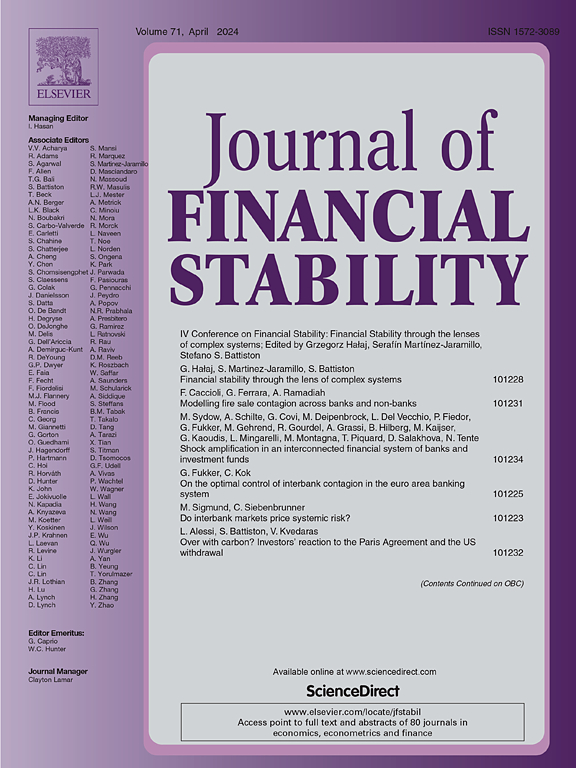分解系统风险:传染和共同暴露的作用
IF 4.2
2区 经济学
Q1 BUSINESS, FINANCE
引用次数: 0
摘要
我们评估传染和共同风险敞口对银行资本的影响,使用源自资产负债表身份的结构性回归框架,并受到结构性VAR文献的启发。传染通过双边风险敞口、低价出售、展期风险和市场情绪产生,而共同风险敞口反映了重叠的投资组合持有。我们使用加拿大银行业的细粒度监管资产负债表和银行间风险敞口数据来估计模型。我们的结果产生了三个关键的见解。首先,在量化宽松开始之前,双边合同风险敞口驱动的传染在一段时间内保持相对稳定。相比之下,非契约性传染渠道不太稳定,并随市场状况而变化。其次,我们观察到,在2019冠状病毒病大流行期间采取了前所未有的财政和货币政策措施后,共同暴露风险增加,传染风险降低。第三,我们展示了我们的框架是如何通过分析第二轮效应来补充传统的银行压力测试方法的。在一个政策应用中,我们模拟了有针对性的救助,并表明它们在稳定系统方面的有效性与被救助机构的相互联系有关。本文章由计算机程序翻译,如有差异,请以英文原文为准。
Decomposing systemic risk: The roles of contagion and common exposures
We evaluate the impact of contagion and common exposures on banks’ capital using a structural regression framework derived from the balance sheet identity and inspired by the structural VAR literature. Contagion arises through bilateral exposures, fire sales, rollover risk, and market-based sentiment, while common exposures reflect overlapping portfolio holdings. We estimate the model using granular regulatory balance sheet and interbank exposure data for the Canadian banking sector. Our results yield three key insights. First, contagion driven by bilateral contractual exposures remains relatively stable over time until the onset of quantitative easing. In contrast, non-contractual contagion channels are less stable and move with market conditions. Second, we observe an increase in common exposure risk along with a decrease in contagion risk, following unprecedented fiscal and monetary policy measures in the COVID-19 pandemic. Third, we demonstrate how our framework complements traditional bank stress-testing approaches that focus on individual institutions by analysing second-round effects. In a policy application, we simulate targeted bailouts and show that their effectiveness in stabilizing the system is related to the interconnectedness of the rescued institution.
求助全文
通过发布文献求助,成功后即可免费获取论文全文。
去求助
来源期刊

Journal of Financial Stability
Multiple-
CiteScore
7.70
自引率
9.30%
发文量
78
审稿时长
34 days
期刊介绍:
The Journal of Financial Stability provides an international forum for rigorous theoretical and empirical macro and micro economic and financial analysis of the causes, management, resolution and preventions of financial crises, including banking, securities market, payments and currency crises. The primary focus is on applied research that would be useful in affecting public policy with respect to financial stability. Thus, the Journal seeks to promote interaction among researchers, policy-makers and practitioners to identify potential risks to financial stability and develop means for preventing, mitigating or managing these risks both within and across countries.
 求助内容:
求助内容: 应助结果提醒方式:
应助结果提醒方式:


